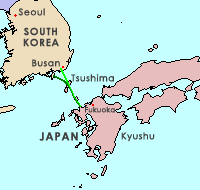Japan–Korea Undersea Tunnel
|
|
|||||||

The proposed routes for the Japan–Korea undersea tunnel.
|
|||||||
| Japanese name | |||||||
|---|---|---|---|---|---|---|---|
| Kanji | |||||||
|
|||||||
| Korean name | |||||||
| Hangul | |||||||
| Hanja | 터널 | ||||||
|
|||||||
| Transcriptions | |
|---|---|
| Romanization | Nikkan Tonneru |
| Transcriptions | |
|---|---|
| Revised Romanization | Hanil Haejeo Teoneol |
| McCune–Reischauer | Hanil Haejŏ T'ŏnŏl |
The Japan–Korea Undersea Tunnel (also Korea–Japan Undersea Tunnel) is a proposed tunnel project to connect Japan with South Korea via an undersea tunnel crossing the Korea Strait using the strait islands of Iki and Tsushima, a straight-line distance of approximately 128 kilometers (80 mi) at its shortest.
The proposal, which has been under discussion intermittently since 1917, was followed with more concrete planning during the early 1940s. It was not pursued, however, until after World War II. In early 2008 the proposal came under renewed discussions by ten senior Japanese lawmakers who established a new committee to pursue it. This was followed by a study group from both countries in early 2009 that agreed to form a committee for the creation of specific construction plans. Committee head Huh Moon-do, a former director of South Korea's National Unification Board and also a key member of the former Chun Doo-hwan government, said the tunnel would help regional economics and would "also play a key role in pursuing bilateral free trade talks" that are currently stalled.
The proposed tunnel would be more than 200 km (120 mi) long and able to serve a portion of freight traffic, as well as some of the approximately 20,000 people who traveled daily between the countries.
A very early discussion on such a tunnel was conducted in 1917 by then-Imperial Japanese Army General Staff officer Kuniaki Koiso (小磯 國昭). Another early proposal for the project originated in the late 1930s as part of the Greater East Asia Railroad (大東亜縦貫鉄道). In 1938, Imperial Japan's Ministry of Communications reportedly decided on a preliminary survey of the sea bottom between Japan and Korea, and during World War II the Imperial Japanese government actively pursued the project in order to connect it with the Korean Peninsula and, ultimately, with the rest of the Asian continent.
...
Wikipedia
